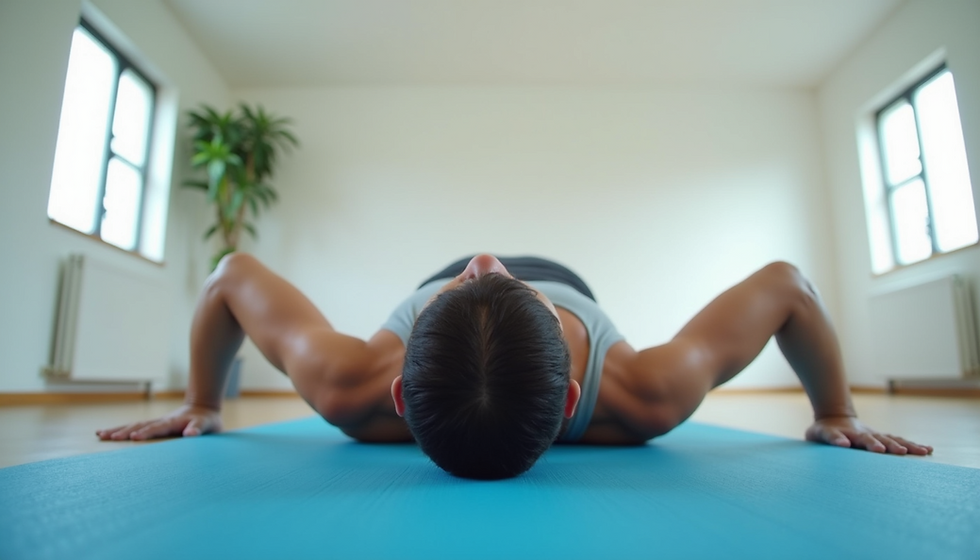Yoga Techniques to Improve Flexibility
- Jill Thorne
- Nov 11
- 4 min read
Flexibility is a key component of physical fitness that enhances movement, reduces injury risk, and improves overall well-being. Many people struggle with tight muscles and limited range of motion, which can affect daily activities and athletic performance. Yoga offers a gentle yet effective way to increase flexibility by combining stretching, breathing, and mindfulness. This post explores practical yoga techniques designed to improve flexibility, helping you move more freely and feel better in your body.
Understanding Flexibility Through Yoga
Flexibility is the ability of muscles and joints to move through their full range of motion. It varies from person to person and can be improved with consistent practice. Yoga is particularly beneficial because it targets multiple muscle groups and encourages gradual lengthening without strain.
When practising yoga for flexibility, it is important to focus on:
Consistency: Regular sessions yield better results than occasional stretching.
Breath control: Deep breathing helps relax muscles and deepen stretches.
Mindfulness: Paying attention to your body’s signals prevents injury and promotes progress.
Incorporating yoga into your routine can improve flexibility in the hips, hamstrings, spine, and shoulders, which are common areas of tightness.

Essential Yoga Poses to Enhance Flexibility Through Yoga
Certain yoga poses are especially effective for increasing flexibility. Here are some foundational asanas to include in your practice:
1. Downward Facing Dog (Adho Mukha Svanasana)
This pose stretches the hamstrings, calves, and spine. Start on your hands and knees, lift your hips towards the ceiling, and straighten your legs as much as possible without locking your knees. Keep your head between your arms and press your heels toward the floor.
Hold for 30 seconds to 1 minute.
Focus on lengthening the spine and opening the shoulders.
2. Cat-Cow Stretch (Marjaryasana-Bitilasana)
This gentle flow warms up the spine and improves flexibility in the back and neck. Alternate between arching your back (cow) and rounding it (cat) while synchronising with your breath.
Repeat for 1-2 minutes.
Move slowly and smoothly.
3. Seated Forward Bend (Paschimottanasana)
This pose targets the hamstrings and lower back. Sit with your legs extended, inhale to lengthen your spine, and exhale as you fold forward from the hips, reaching for your feet or shins.
Hold for 30 seconds to 2 minutes.
Avoid forcing the stretch; go only as far as comfortable.
4. Butterfly Pose (Baddha Konasana)
This hip opener stretches the inner thighs and groin. Sit with the soles of your feet together and knees dropped to the sides. Hold your feet and gently press your knees toward the floor.
Hold for 1-3 minutes.
Keep your spine straight and breathe deeply.
5. Cobra Pose (Bhujangasana)
This backbend increases flexibility in the spine and chest. Lie on your stomach, place your hands under your shoulders, and gently lift your chest while keeping your elbows slightly bent.
Hold for 15-30 seconds.
Avoid overextending the lower back.
Practising these poses regularly will gradually improve your flexibility and mobility.
How to Safely Improve Flexibility with Yoga
Improving flexibility requires patience and care. Here are some tips to ensure a safe and effective yoga practice:
Warm up first: Begin with gentle movements or light cardio to increase blood flow.
Use props: Blocks, straps, and cushions can help you maintain proper alignment and reduce strain.
Avoid bouncing: Stretch slowly and steadily to prevent muscle tears.
Listen to your body: Mild discomfort is normal, but sharp pain is a warning sign.
Breathe deeply: Inhale to prepare, exhale to deepen the stretch.
Stay consistent: Aim for at least 3 sessions per week for noticeable improvements.
Remember, flexibility gains happen over time. Celebrate small progress and avoid comparing yourself to others.

Integrating Yoga for Flexibility Into Your Daily Routine
Making yoga a part of your daily life can be simple and rewarding. Here are some practical ways to incorporate flexibility-enhancing yoga:
Morning stretch: Start your day with 10-15 minutes of gentle yoga to wake up your muscles.
Lunch break reset: Use a short session to relieve tension from sitting.
Evening wind-down: Practice calming poses to relax and improve flexibility before bed.
Weekend longer sessions: Dedicate 30-60 minutes to a full yoga flow focusing on flexibility.
You can also combine yoga with other activities like walking or swimming for balanced fitness. If you are new to yoga, consider joining a class or following online tutorials to learn proper techniques.
For those interested in exploring more about yoga for flexibility, there are many resources available that provide detailed guidance and support.
Beyond Flexibility: Additional Benefits of Yoga Practice
While improving flexibility is a major advantage, yoga offers many other benefits that enhance overall health:
Improved posture: Strengthening core muscles supports better alignment.
Stress reduction: Mindful breathing and movement calm the nervous system.
Increased strength: Holding poses builds muscle tone.
Better balance: Yoga enhances coordination and body awareness.
Pain relief: Regular practice can alleviate chronic pain conditions.
By committing to yoga, you invest in a holistic approach to wellness that nurtures both body and mind.
Embracing yoga techniques to improve flexibility can transform your physical capabilities and quality of life. Start with simple poses, practise safely, and enjoy the journey toward a more flexible, balanced, and healthy you.




Comments